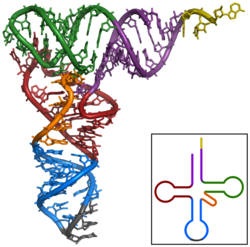Translation (genetics)
Translation is the second part of protein biosynthesis (the making of proteins). It is part of the process of gene expression.
Before translation comes:
- transcription, which produces a chain of introns and exons.
- RNA splicing by spliceosomes which remove introns, and
- formulation of the messenger RNA from exons.
In eukaryotes, translation happens on the ribosomes in the cytoplasm and in the endoplasmic reticulum. In bacteria, translation happens in the cell cytoplasm: they have no nucleus.
Ribosomes are made of a small part and a large part which surround the mRNA (messenger RNA). In translation, mRNA has the base sequence to make a specific polypeptide. This sequence is originally specified by the DNA, and copied by the mRNA. The polypeptide can be a whole protein. Or, it can be just a part, waiting to be combined with other polypeptides so it can make a whole protein. The polypeptide also has to be folded before it works as a protein.
Amino acids are carried by specific tRNAs with anticodons to connect with mRNA's matching codons. Each tRNA has its own anticodon and carries an amino acid. An anticodon is always together with the same amino acid.
When the tRNA matches with the mRNA, the amino acid that is connected to the tRNA is unconnected from the tRNA and gets connected to the amino acid brought by the previous tRNA.
So, a ribosome works a lot like a stock ticker and ticker tape. Many ribosomes, together with mRNA, will attach themselves to the outer membrane of the rough endoplasmic reticulum. Any proteins that those ribosomes make go into the inside of the endoplasmic reticulum, where it will probably go into a vesicle later. The vesicles will then bring the proteins to other organelles or even the outside of the cell.
Four stages
Translation happens in four stages: activation (make ready), initiation (start), elongation (make longer) and termination (stop). These terms describe the growth of the amino acid chain (polypeptide).
- Amino acids are brought to ribosomes and assembled into proteins. In the activation stage, the correct amino acid is covalently bonded to the correct transfer RNA (tRNA). When the tRNA is connected to an amino acid, it is "charged".
- Initiation is when the small part of the ribosome connects to 5' end of the mRNA with the help of initiation factors (IF).
- Elongation is when the amino acids brought by the "charged" tRNAs are connected to each other to form a polypeptide.
Some antibiotics work by keeping translation from happening. Prokaryotic ribosomes are different from eukaryotic ribosomes. So antibiotics can kill bacteria without hurting the eukaryotic host. For example, antibiotics taken by a human might kill the bacteria that is making the human sick but wouldn't hurt the human.
Translation (genetics) Media
A ribosome translating a protein that is secreted into the endoplasmic reticulum (tRNAs colored dark blue). Protein domain dynamics can now be seen by neutron spin echo spectroscopy
Initiation and elongation stages of translation involving RNA nucleobases, the ribosome, transfer RNA, and amino acids
Figure M0. Basic and the simplest model M0 of protein synthesis. Here, M – amount of mRNA with translation initiation site not occupied by assembling ribosome, F – amount of mRNA with translation initiation site occupied by assembling ribosome, R – amount of ribosomes sitting on mRNA synthesizing proteins, P – amount of synthesized proteins.
References
- Champe, Pamela C. Harvey, Richard A. and Ferrier, Denise R. 2005. Lippincott's illustrated reviews: Biochemistry 3rd ed, Lippincott Williams & Wilkins. ISBN 0-7817-2265-9.
- Nelson, David L. Cox, Michael M. and Lehninger, Albert L. 2005. Lehninger principles of biochemistry 4th ed, Freeman. ISBN 0-7167-4339-6.




